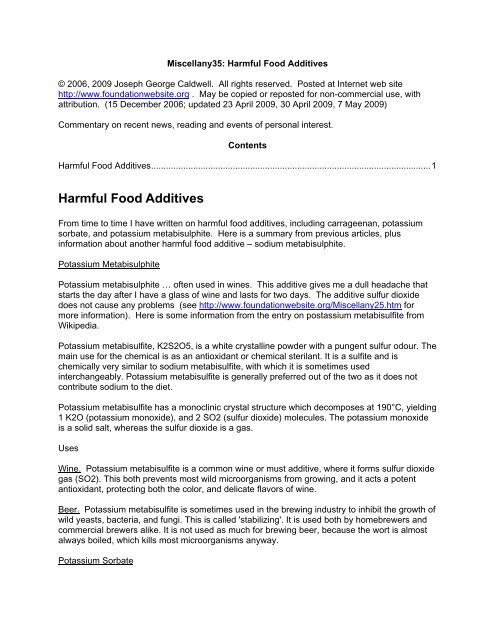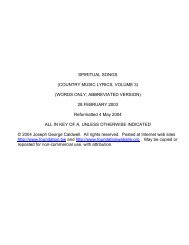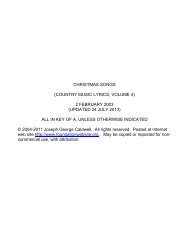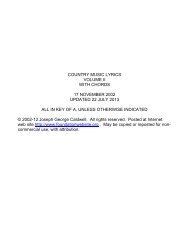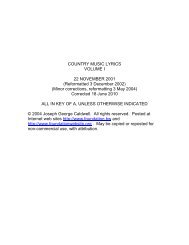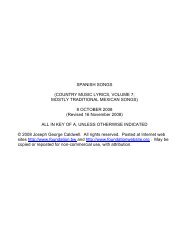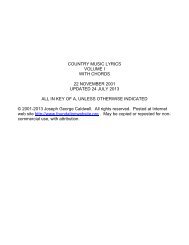Harmful Food Additives - Foundationwebsite.org
Harmful Food Additives - Foundationwebsite.org
Harmful Food Additives - Foundationwebsite.org
Create successful ePaper yourself
Turn your PDF publications into a flip-book with our unique Google optimized e-Paper software.
Miscellany35: <strong>Harmful</strong> <strong>Food</strong> <strong>Additives</strong>© 2006, 2009 Joseph Ge<strong>org</strong>e Caldwell. All rights reserved. Posted at Internet web sitehttp://www.foundationwebsite.<strong>org</strong> . May be copied or reposted for non-commercial use, withattribution. (15 December 2006; updated 23 April 2009, 30 April 2009, 7 May 2009)Commentary on recent news, reading and events of personal interest.Contents<strong>Harmful</strong> <strong>Food</strong> <strong>Additives</strong>.................................................................................................................1<strong>Harmful</strong> <strong>Food</strong> <strong>Additives</strong>From time to time I have written on harmful food additives, including carrageenan, potassiumsorbate, and potassium metabisulphite. Here is a summary from previous articles, plusinformation about another harmful food additive – sodium metabisulphite.Potassium MetabisulphitePotassium metabisulphite … often used in wines. This additive gives me a dull headache thatstarts the day after I have a glass of wine and lasts for two days. The additive sulfur dioxidedoes not cause any problems (see http://www.foundationwebsite.<strong>org</strong>/Miscellany25.htm formore information). Here is some information from the entry on postassium metabisulfite fromWikipedia.Potassium metabisulfite, K2S2O5, is a white crystalline powder with a pungent sulfur odour. Themain use for the chemical is as an antioxidant or chemical sterilant. It is a sulfite and ischemically very similar to sodium metabisulfite, with which it is sometimes usedinterchangeably. Potassium metabisulfite is generally preferred out of the two as it does notcontribute sodium to the diet.Potassium metabisulfite has a monoclinic crystal structure which decomposes at 190°C, yielding1 K2O (potassium monoxide), and 2 SO2 (sulfur dioxide) molecules. The potassium monoxideis a solid salt, whereas the sulfur dioxide is a gas.UsesWine. Potassium metabisulfite is a common wine or must additive, where it forms sulfur dioxidegas (SO2). This both prevents most wild micro<strong>org</strong>anisms from growing, and it acts a potentantioxidant, protecting both the color, and delicate flavors of wine.Beer. Potassium metabisulfite is sometimes used in the brewing industry to inhibit the growth ofwild yeasts, bacteria, and fungi. This is called 'stabilizing'. It is used both by homebrewers andcommercial brewers alike. It is not used as much for brewing beer, because the wort is almostalways boiled, which kills most micro<strong>org</strong>anisms anyway.Potassium Sorbate
Potassium sorbate … used as a preservative in many things, especially in drinks containingcitric acid, in apple juice, and in cocktail mixers such as coconut cream. If I ingest it from adrink, it causes a severe pain in the center of my chest, and makes breathing difficult. It isknown to have caused fatal reactions. If I ingest it from a non-drink, such as a peach preserve,then it does not cause a severe chest pain, but simply palpitations of the heart for several hours,and pressure and pounding in the head.Update 23 April 2009I have written previously about harmful food additives. The following is an extract from thesection “Where Has All the Flavor Gone” of my article Miscellany 18, posted athttp://www.foundationwebsite.<strong>org</strong>/Miscellany18.htm . See also the section “Australian Wine: NoAdded Sulfites, No Headaches” of my article Miscellany25, posted athttp://www.foundationwebsite.<strong>org</strong>/Miscellany25.htm .There are plenty of other additives that are harmful to human beings. I am allergic to potassiumsorbate, which is a preservative often used in citrus drinks, such as apple juice, wine coolers, orcocktail mixes, such as piña colada or daiquiri mix. This chemical causes me to have severechest pain, and difficulty breathing. This reaction is not all that uncommon, and can be fatal.If you check the World Wide Web on the Internet (search phrase “potassium sorbate”), you willfind that some people claim that potassium sorbate has been given a bum rap – that it is not atall dangerous. For example, the Lumen <strong>Food</strong>s website states, “It is hard to imagine a naturallyoccurringnutrient that has been more maligned or more mischaracterized than potassiumsorbate – the potassium salt of sorbic acid.” (http://www.soybean.com/ps.htm ). Whatever badpress potassium sorbate has been given is richly deserved. This preservative is verydangerous, and can be fatal.(It took me quite a while to find out that I was allergic to potassium sorbate. Every once in awhile I would have a terrible reaction to a soft drink or mix. I would read the labels of what I haddrunk, but there were always so many added chemicals that I could not determine which onewas causing my problem. Then, one day, in the early 1980s, a friend offered me a “winecooler,” which triggered the allergic reaction. To my good fortune, the wine cooler had but asingle added ingredient – potassium sorbate. My problem was solved. As chance would haveit, my children heard a television report a couple of weeks later, discussing the fact thatpotassium sorbate preservatives could cause fatal reactions.)Unfortunately for me, I am allergic to the sulfites that occur, either added or naturally, in wine. IfI take a large glass of red wine, I almost always get a headache that starts the next morning andlasts for the rest of the day, the night, and the next day. Fortunately, I can purchase, in somestores, “<strong>org</strong>anic” wines, to which no sulfites have been added. Wines from France, Italy, andother foreign countries also tend not to have sulfites added. Champagne appears to have lowerlevels of sufites.It is a shame that so many poisons are added to our food. No wonder today’s food tastes sobad. No wonder there has been such an increase in colon cancer. We are simply pickling ourguts. [End of update.]Here is information extracted from the Wikipedia on potassium sorbate.2
Potassium sorbate is a mild preservative. Its primary use is as a food preservative (E number202). Its molecular formula is C6H7O2K and its systematic name is potassium (E,E)-hexa-2,4-dienoate. Potassium sorbate is effective in a variety of applications including food, wine, andpersonal care.UsagePotassium sorbate is used to inhibit molds, and yeasts in many foods, such as cheese, wine,yogurt, and baked goods. It can also be found in the ingredients list of many dried fruit products.In addition, herbal dietary supplement products generally contain potassium sorbate, which actsto prevent mold and microbes and to increase shelf life, and is used in such tiny quantities thatthere is no known adverse health effects. Labeling of this preservative reads as "potassiumsorbate" on the ingredient statement. Also, it is used in many personal care products to inhibitthe development of micro<strong>org</strong>anisms for shelf stability. Some manufacturers are using thispreservative as a replacement for parabens.Also known affectionately as "wine stabilizer", potassium sorbate produces sorbic acid whenadded to wine. It serves two purposes. When active fermentation has ceased and the wineracked the final time after clearing, potassium sorbate will render any surviving yeast incapableof multiplying. Yeast living at that moment can continue fermenting any residual sugar into CO2and alcohol, but when they die no new yeast will be present to cause future fermentation. Whena wine is sweetened before bottling, potassium sorbate is used to prevent refermentation whenused in conjunction with potassium metabisulfite. It is primarily used with sweet wines andsparkling wines, but may be added to table wines which exhibit difficulty in maintaining clarityafter fining.Some molds (notably some Trichoderma and Penicillium strains) and yeasts are able to detoxifysorbates by decarboxylation, producing 1,3-pentadiene. The pentadiene manifests as a typicalodor of kerosene or petroleum.SynthesisPotassium sorbate is the potassium salt of sorbic acid.ToxicologyThis gentle preservative is considered to be safe and mild because of its long term safety recordand non-toxic profile. Potassium sorbate is non-irritating and non-sensitizing. Although allergicreactions to potassium sorbate is very rare and it is well tolerated when administered internally,sorbic acid is a possible skin irritant, and may cause rashes, asthma and hyperactivity. In rarecases, this can translate to an allergic reaction to potassium sorbate. It may also affectchildren’s health, behaviour and learning and can be found on lists of additives to avoid, withalternatives being refrigeration, freezing and ascorbates 300-304.[End of Wikipedia extract.]The Wikipedia article is flat-out wrong on the “gentleness” of potassium sorbate. It causessevere reactions in some people, and can be fatal.Carrageenan3
Carrageenan … used as a thickener in many products, such as ice cream and yogurt. Causesstomache upset, deterioration of mammary-gland tissues. In some formulations, is carcinogenic(see http://www.foundationwebsite.<strong>org</strong>/Miscellany18.htm for more information).Here is some information from Wikipedia on carrageenan.Carrageenans or carrageenins are a family of linear sulphated polysaccharides extracted fromred seaweeds. The name is derived from a type of seaweed that is abundant along the Irishcoastline near the village of Carragheen. Gelatinous extracts of carrageen seaweed (alsoknown as Irish moss) have been used as food additives for hundreds of years. Research hasraised concerns about the health implications of carrageenan consumption.UsesCarrageenans are large, highly flexible molecules which curl forming helical structures. Thisgives them the ability to form a variety of different gels at room temperature. They are widelyused in the food and other industries as thickening and stabilizing agents. A particularadvantage is that they are thixotropic—they thin under shear stress and recover their viscosityonce the stress is removed. This means that they are easy to pump but stiffen again afterwards.For example, they can be used in:Desserts, ice cream, milk shakes, sauces - gel to increase viscosity, PayDay bars containcarrageenans.Beer - clarifier to remove haze-causing proteinsPâtés and processed meat - Substitute fat to increase water retention and increase volumeToothpaste - stabilizer to prevent constituents separatingFire fighting foam - thickener to cause foam to become stickyShampoo and cosmetic creams - thickenerAir freshener gelsShoe polish - gel to increase viscosityBiotechnology - gel to immobilize cells/enzymesPersonal lubricants - laboratory studies suggest that carrageenans might function as a topicalmicrobicides, blocking sexually-transmitted viruses such as HIV, HPV and herpes [2][3]Lambda carrageenan is used in animal models of inflammation used to test analgesics. Dilutecarrageenan solution (1-2%) injected subcutaneously causes swelling and pain.There are three main commercial classes of carrageenan:Kappa - strong, rigid gels. Produced from Kappaphycus cottoniiIota - soft gels. Produced from Eucheuma spinosumLambda - form gels when mixed with proteins rather than water, used to thicken dairy products.The most common source is Gigartina from Southern Europe.It is interesting to note, however, that a lot of red algal species produce different types ofcarrageenans during their developmental history. For instance, the genera Gigartina producesmainly Kappa carrageenans during its gametophytic stage, and Lambda carrageenans duringits sporophytic stage.All are soluble in hot water, but in cold water only the Lambda form (and the sodium salts of theother two) are soluble.4
When used in food products, carrageenan has the EU additive E-number E407. Althoughintroduced on an industrial scale in the 1930s, the first use was in China around 600 BC (whereGigartina was used) and in Ireland around 400 AD.The largest producer is the Philippines, where cultivated seaweed produces about 80% of theworld supply. The most commonly used are Cottonii (Eucheuma cottonii) and Spinosum(Eucheuma spinosum), which together provide about three quarters of the World production.These grow at sea level down to about 2 metres. The seaweed is normally grown on nylon linesstrung between bamboo floats and harvested after three months or so when each plant weighsaround 1 kg.The Cottonii variety has been reclassified as Kappaphycus cottonii by Maxwell Doty (1988),thereby introducing the genus Kappaphycus, on the basis of the phycocolloids produced(namely kappa carrageenan).After harvest, the seaweed is dried, baled, and sent to the carrageenan manufacturer. There theseaweed is ground, sifted to remove impurities such as sand, and washed thoroughly. Next, thecellulose is removed from the carrageenan by centrifugation and filtration. The resultingcarrageenan solution is then concentrated by evaporation. It is dried and ground tospecification.Health concernsThere is evidence from studies performed on rats, guinea pigs and monkeys which indicatesthat degraded carrageenan (poligeenan) may cause ulcerations in the gastro-intestinal tract andgastro-intestinal cancer. Poligeenan is produced from carrageenan subjected to hightemperatures and acidity. The average carrageenan molecule weighs over 100,000 Da whilepoligeenans have a molecular weight of less than 50 kDa. A scientific committee working onbehalf of the European Commission has recommended that the amount of degradedcarrageenan be limited to a maximum of 5% (which is the limit of detection) of total carrageenanmass. Upon testing samples of foods containing high molecular weight carrageens, researchersfound no poligeenan.TriviaCarrageenan has also been used to thicken skim milk, in an attempt to emulate the consistencyof whole milk. This usage did not become popular.[End of Wikipedia extract.]Sodium MetabisulfiteSodium metabisulfite … used for color retention in sugar-free milk chocolate. Causesimmediate and severe diarrhea, gas, and abdominal pain, lasting for about a day.Here is information on Wikipedia on sodium metabisulfite.Sodium metabisulfite or sodium pyrosulfite (American spelling; English spelling is Sodiummetabisulphite or sodium pyrosulphite) is an in<strong>org</strong>anic compound of chemical formulaNa2S2O5. The name is sometimes referred to as disodium (metabisulfite, etc). It is used as asterilizer and antioxidant/preservative.5
Uses<strong>Food</strong> additive. It is used as a food additive, mainly as a preservative and is sometimesidentified as E223. As an additive, it may cause allergic reactions, particularly skin irritation,gastric irritation and asthma. It is not recommended for consumption by children.Sterilization / Cleaning agent. It is commonly used in homebrewing preparations to sanitizeequipment.It is also used as a cleaning agent for potable water reverse osmosis membranes indesalination systems.Packaging. It can be purchased in powdered form, and is also the primary ingredient incampden tablets. In solid form it ranges in color from white to slightly yellow. Sodiummetabisulfite is also used to remove chloramine from drinking water.Chemical propertiesWhen mixed with water, sodium metabisulfite releases sulfur dioxide (SO2), a pungent,unpleasant smelling gas that can also cause breathing difficulties in some people. For thisreason, sodium metabisulfite has fallen from common use in recent times, with agents such ashydrogen peroxide becoming more popular for effective and odorless sterlization of equipment.Sodium metabisulfite is also used to remove chloramine from drinking water after treatment, aswell as many industrial uses.[End of Wikipedia article.]Here is information from the BASF Chemical Company website(http://www.in<strong>org</strong>anics.basf.com), a producer of sodium metabisulfite.ApplicationsIn the chemical and pharmaceutical industries for various purposes , e. g. as a reducing agent,for purifying and isolating aldehydes and ketones. For destroying waste bromine.In drinking water treatment to remove excess chlorine. In the treatment of wastewater, e. g. fromelectroplating plants, to neutralize chromic acid; to remove excess chlorine in the neutralizationof cyanide. In special cases to remove oxygen from boiler feed water.For cleaning and bleaching wool, jute, and other vegetable fibres.In the paper and pulp industry for bleaching ground wood.Sodium Metabisulfite photo grade in the photographic and film industry for preparing developersolutions, for acidifying fixing baths.Sodium Metabisulfite food grade (E223): For preserving foodstuffs (restricted use in accordancewith the additives approval regulations, E 223). As anti-melanosis additive for sea food.SafetyRisk of serious damage to eyes. Contact with acids liberates toxic sulfur dioxide (SO₂) gas.<strong>Harmful</strong> if swallowed. Higher concentrations of the substance may cause a strong chemical6
oxygen consumption in biological sewage-treatment plants and/or waterways. Avoid contactwith nitrites and nitrates and strong oxidizing agents: violent reactions are possible.During the handling of these products the data and reference in the safety data sheet are to beconsidered. In addition the necessary caution and good industrial hygiene while handlingchemicals have to been kept.[End of BASF extract.]Here is some additional information from the Kencro Chemicals website (http://www.kencro.ca ).Toxicological properties:Route of entrySkin contactEye contactInhalationIngestionEffectMay cause skin irritation with prolonged exposure. Sulphite sensitiveindividual may experience a severe and deadly allergic reaction.May cause moderate irritation. Prolonged contact may be severelyirritating or cause burns.May cause irritating effects of the respiratory tract. Breathing of dust mayaggravate asthma or other pulmonary diseases. May produce gastrointestinal upset, nausea or vomiting.Will cause adverse health effects. Ingestions of large doses may be fatal,Update 30 April 2009Because I am allergic to potassium sorbate and potassium metabisulphite, I read the ingredientlabels of the foods and drinks I consume. Unfortunately, many food producers do not use theordinary chemical names for additives, but use the International Numbering System (INS)numbers issued by the Codex Alimentarius Commission of the <strong>Food</strong> and AgriculturalOrganization / World Health Organization (FAO/WHO) of the United Nations (UN). Thefollowing is a list of 45 additives having the functional class “preservative,” from the CodexGeneral Standard for <strong>Food</strong> <strong>Additives</strong> (GSFA) Online Database, athttp://www.codexalimentarius.net (the list is from URLhttp://www.codexalimentarius.net/gsfaonline/additives/results.html?techFunction=18&searchBy=tf ).INS No. <strong>Food</strong> Additive or Group220 Sulfur dioxide512 Stannous chloride200 Sorbic acid221 Sodium sulfite201 Sodium sorbate281 Sodium propionate232 Sodium ortho-phenylphenol250 Sodium nitrite251 Sodium nitrate223 Sodium metabisulfite222 Sodium hydrogen sulfite262(ii) Sodium diacetate211 Sodium benzoate262(i) Sodium acetate7
280 Propionic acid225 Potassium sulfite202 Potassium sorbate283 Potassium propionate249 Potassium nitrite252 Potassium nitrate224 Potassium metabisulfite228 Potassium bisulfite212 Potassium benzoate235 Pimaricin (Natamycin)231 ortho-Phenylphenol234 Nisin218 Methyl para-hydroxybenzoate1105 Lysozyme384 Isopropyl citrates239 Hexamethylene tetramine1102 Glucose oxidase from Aspergillus niger var.236 Formic acid579 Ferrous gluconate214 Ethyl para-hydroxybenzoate386 Disodium ethylene diamine tetra acetate230 Diphenyl242 Dimethyl dicarbonate203 Calcium sorbate282 Calcium propionate227 Calcium hydrogen sulfite385 Calcium disodium ethylene diamine tetra acetate213 Calcium benzoate263 Calcium acetate210 Benzoic acid260 Acetic acid, glacialThe numbers that I look for are 202 (potassium sorbate), 223 (sodium metabisulfite) and 224(potassium metabisulfite). I also look for 407, which is the INS number for carrageenan and itssalts, and for 461, which is the INS number for methyl cellulose. I am not allergic tocarrageenan or methyl cellulose, but I find them very hard to digest. They are often used asthickeners, such as in ice cream or yogurt, to make them “smooth and creamy.” If I eat icecream containing carrageenan or methyl cellulose, the ice cream will “stay” in my stomach foran hour or so (the uncomfortable feeling of indigestion – I imagine the same feeling as if I hadeaten cotton, grass or seaweed, which are somewhat similar to these chemicals). Otherthickeners such as guar gum (INS No. 412) and xanthan gum (INS No. 415) and pectins (INSNo. 440) do not bother me – except to give ice cream and yogurt a strange, unnaturalconsistency (pectin less so than the gums).If you are interested, take a look at the Codex Alimentarius GSFA Online website. It is veryinteresting to read about the many additives that are added to our food. There are 23 foodadditive functional classes: Acid, Acidity regulator, Anticaking agent, Antifoaming agent,Antioxidant, Bulking agent, Colour, Colour retention agent, Emulsifier, Emulsifying salt, Firmingagent, Flavour enhancer, Flour treatment agent, Foaming agent, Gelling agent, Glazing agent,Humectant, Preservative, Propellant, Raising agent, Stabilizer, Sweetener, and Thickener.Within these categories are about 300 chemicals or chemical groups. Given that many of these8
chemicals are synthetic, it is no wonder that human beings now have so many allergies andailments – the diet of industrial civilization consists of a myriad of chemicals that mankind neveringested during its evolution. The additives that cause me severe reactions are of the“preservative” functional class. If you have allergies or other symptoms (e.g., restless legsyndrome, often caused by monosodium glutamate (INS No. 621)), it would be rational to startexamining the ingredients in the foods that you eat, and see if you can trace the problem to oneor more additives. [End of update.]Update 7 May 2009In the United States, the use of INS numbers is rare – most labels contain chemical names, notINS numbers. In Europe and a number of other countries, the use of INS numbers is prevalent.In Europe, INS numbers are preceded on labels with an “E”, and they are called “E-numbers.”Here follows part of the Wikipedia entry for “E-Number”:“E numbers are number codes for food additives and are usually found on food labelsthroughout the European Union. The numbering scheme follows that of the InternationalNumbering System (INS) as determined by the Codex Alimentarius committee. Only a subset ofthe INS additives are approved for use in the European Union, the 'E' prefix which stands forEurope. In casual language in the UK and Ireland, the term "E-number" is used as a pejorativeterm for artificial food additives, and products may promote themselves as "free of E-numbers"even though most of the (natural) ingredients contain components that also have an E-number(e.g. Vitamin C (E300) or lycopene, the colour in tomatoes). To have a diet without anycomponents that also have an E-number is basically impossible. Free of E-numbers thus refersmainly to the use of additives, not to the absence of components with an E-number.“E numbers are also encountered on food labeling in other jurisdictions, including the GCC [GulfCooperation Council], Australia, New Zealand and Israel. The "E" prefix is omitted in Australiaand New Zealand. They are increasingly (though still rarely) found on North Americanpackaging, especially in Canada.”The Wikipedia entry contains the following table, which summarizes E-numbers by numericrange.Classification by numeric range100–199Colours100–109 yellows110–119 oranges120–129 reds9
130–139 blues & violets140–149 greens150–159 browns & blacks160–199 others200–209 sorbates210–219 benzoates220–229 sulphites230–239 phenols & formates (methanoates)200–299Preservatives240–259 nitrates260–269 acetates (ethanoates)270–279 lactates280–289 propionates (propanoates)290–299 others300–399 300–305 ascorbates (vitamin C)10
Antioxidants & acidityregulators306–309 Tocopherol (vitamin E)310–319 gallates & erythorbates320–329 lactates330–339 citrates & tartrates340–349 phosphates350–359 malates & adipates360–369 succinates & fumarates370–399 others400–499Thickeners, stabilisers &emulsifiers400–409 alginates410–419 natural gums420–429 other natural agents430–439 polyoxyethene compounds440–449 natural emulsifiers450–459 phosphates11
460–469 cellulose compounds470–489 fatty acids & compounds490–499 others500–509 mineral acids & bases510–519 chlorides & sulphates520–529 sulphates & hydroxides500–599pH regulators & anti-cakingagents530–549 alkali metal compounds550–559 silicates570–579 stearates & gluconates580–599 others620–629 glutamates600–699Flavour enhancers630–639 inosinates640–649 others900–999 900–909 waxes12
Miscellaneous910–919 synthetic glazes920–929 improving agents930–949 packaging gases950–969 sweeteners990–999 foaming agents1100–1599Additional chemicalsNew chemicals that do not fall into standard classificationschemesNB: Not all examples of a class fall into the given numeric range. Moreover, many chemicals,particularly in the E400–499 range, have a variety of purposes.[End of Wikipedia extract.]The Wikipedia article contains much additional information about each specific additive, such aswhich ones are dangerous or are banned in the European Union.INS numbers (E-numbers) are of particular interest to Jews and Moslems, because they canindicate whether an additive is made from a proscribed food product, such as pork or shellfish.Here follows an entry from the WorldOfIslam Portal (http://special.worldofislam.info/<strong>Food</strong>/numbers.html ).“E-Numbers represent specific food additives, used by the food industry in the manufactureof various food products. These E-Numbers have been formulated by the EuropeanEconomic Community (EEC) and are universally adopted by the food industry worldwide.”It is known that many E-numbers contain unlisted haraam ingredients in them. Generallyadditives derived from animals and insects.“E-numbers are reference numbers used by the European Union to facilitate identification offood additives. All food additives used in the European Union are identified by an E-number.The "E" stands for "Europe" or "European Union". Normally each food additive is assigned aunique number, though occasionally, related additives are given an extension ("a", "b", or"i", "ii") to another E-number.13
“The Commission of the European Union assigns e-numbers after the additive is cleared bythe Scientific Committee on <strong>Food</strong> (SCF), the body responsible for the safety evaluation offood additives in the European Union. The convention for assigning E-numbers is:100-199 food colors200-299 preservatives300-399 antioxidants, phosphates, and complexing agents400-499 thickeners, gelling agents, phosphates, humectants, emulsifiers500-599 salts and related compounds600-699 flavor enhancers700-899 not used for food additives (used for feed additives)900-999 surface coating agents, gases, sweeteners1000-1399 miscellaneous additive1400-1499 starch derivativesE-numbers are only used for substances added directly to food products, so contaminants,enzymes and processing aids, which may be classified as additives in the USA, are notincluded in the E-number system.There is an EU directive on food labeling which requires food additives to be listed in theproduct ingredients whenever they are added for technological purposes. This includescoloring, sweetening and favor enhancement as well as for preservation, thickening,emulsifying and the like. Ingredients must be listed in descending order of weight, whichmeans that are generally found close to the end of the list of ingredients. However,substances used in the protection of plants and plant products, flavorings and substancesadded as nutrients (e.g., minerals, trace elements or vitamins) do not need to be includedin the ingredient list. Because of this, some substances that are regulated as food additivesin other countries may be exempt from the food additive definition in the EU.<strong>Additives</strong> which are ALWAYS of animal origin, such as (HARAAM):• E120 Cochineal : a red colour obtained from female insects• E441 Gelatine : derived from the bones and/ or hides of cattle and/ or pigs• E542 Edible Bone Phosphate : an extract from animal bones• E904 Shellac : a resin from the lac insectWhilst some additives with a common code such as E47, can be either of animal orplant origin and this latter type needs to be investigated on a case-by-case basis perproduct/ manufacturer.The main additives you need to be aware of are:• Glycerol / Glycerin / Glycerine (E422) - haraam if obtained from pork or non-halalmeat sources.14
• Emulsifiers (E470 to E483) - haraam if obtained from pork or non-halal sources.• Edible Bone Phosphate (E542) - haraam if obtained from pork or non-halal meatsources.”[End of extract from WoldOfIslam Portal.]15


